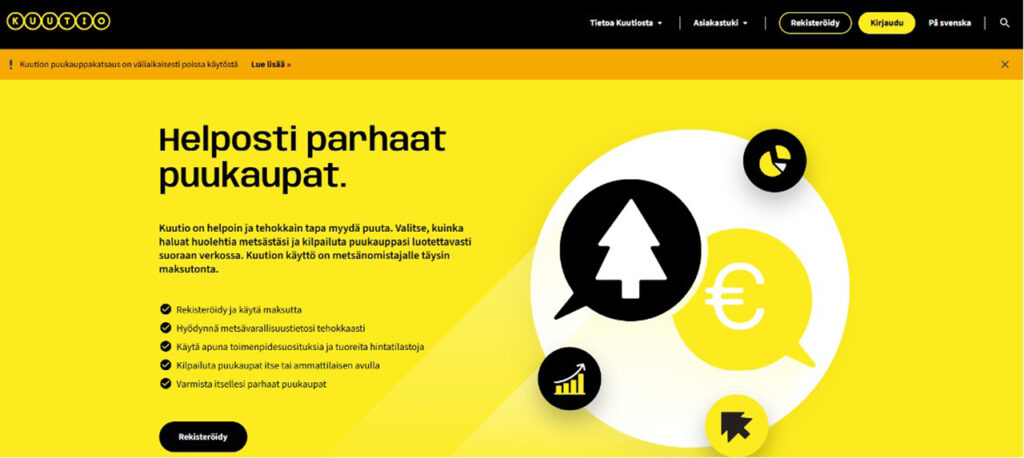Finland makes forest resources visible: Forestry digital transformation and strategic data management with an eye to the future of forests
Updated by Nozomu Kanemoto on July 02, 2025, 2:22 PM JST
Nozomi KANEMOTO
Leaf Rain Co.
He joined the Japan Forest Technology Association in 2021 and has been involved in several ODA projects in the forestry sector, calculating GHG emission reductions and managing project operations. 2024 he became independent and is currently working in the forestry sector based in France.
About two-thirds of Japan's land area is covered with forests, making it known as a "forest-rich country (*1). While these vast forests are important resources that support a rich natural environment and diverse ecosystems, their management and preservation require a great deal of labor and time. In addition, the traditional manual forest management is reaching its limits due to the declining birthrate and aging population, as well as a decrease in the number of forestry workers.
In order to resolve these issues and achieve carbon neutrality by 2050 and the SDGs, "Forest and Forestry DX (Digital Transformation)" (*2) is being promoted. Forest and forestry DX refers to efforts to achieve sustainable forest management by utilizing digital technology to improve the efficiency and sophistication of forest management and forestry. Specifically, it includes the introduction of advanced technologies such as ICT and AI, and the establishment of a system to manage and conserve forests with an accurate understanding of their condition.
Forest and forestry DX is spreading throughout Japan. The Kumamoto Prefecture Federation of Forestry Cooperatives has been introducing remote sensing technology and has been using aircraft-mounted lasers to clarify forest boundaries in approximately 1,000 hectares of mountain forests since 2016 (*3). Remote sensing is a method of acquiring forest information without direct measurement using drones, satellites, aircraft-mounted sensors, and ground-mounted lasers. Thus, forestry and forestry DX is attracting attention as an important means of supporting sustainable forest management by utilizing remote sensing and other advanced technologies to reduce labor and increase precision in tasks that previously required manpower and time.
*Reference 1:March 2025 Web Magazine: Food and Lifestyles Today," Ministry of Agriculture, Forestry and Fisheries (reference date: June 19, 2025).
*Refer 2:Mikako Wakitani (Pacific Consultants K.K.), "What are the 8 New Tools of an Expert Group Solving Forest Challenges with Innovative Technology?" FOREST JOURNAL (reference date June 19, 2025)
*Reference 3: Forestry Agency, "Guidance on remote sensing technologies and their use for the development and utilization of high-precision forest information," March 2018, page 86.
In other countries, such as the Nordic countries and Canada, the forest and forestry sector is further advancing DX. Of particular note is the case of Finland, where approximately 74% of the national territory is covered by forests. While Finland's climate and topography differ from Japan's, the two countries share similarities in terms of forest area, forest coverage, and the fact that most forests are small-scale and privately owned. (*4) Since the 1980s, Finland's forestry industry has been simultaneously mechanizing and digitizing its forestry sites, and forestry utilizing digital technology has now taken root in society. Noteworthy is the comprehensiveness and advanced nature of forest resource data managed at the national level.
The forest resource database operated by the Forest Center is one of the largest in the world, holding data for approximately 13.9 million hectares, or 99% of private forests. Data is collected using aircraft-mounted lasers and aerial photographs, in addition to measurements of sample plots. In addition, information obtained at the time of harvesting (tree species, harvest location, tree quality, length, thickness, etc.) is also registered. This allows forest owners to accurately assess the condition of their forests and confirm their harvest plans and forest management recommendations.

In addition, you can file forest tax returns, sell timber, order management tasks, and consult on a variety of matters from our digital services. You can register for free for digital timber trading (KUUTIO.), you can use the forest resource data as it is, submit a request to the timber company for what you want to sell, and even conduct the transaction. In this way, a forestry infrastructure is in place that allows everything from field data collection to forest tax reporting and sales to be done digitally.
Such Finnish efforts are not simply digitalization to improve forestry productivity, but are a useful tool for sustainable forest resource management based on the perspective of "how to preserve the forests of today for the future. However, it is difficult to apply the Finnish approach directly to Japan because of differences in tree species, topography, and other prerequisites. What is important here is to learn from the Finnish philosophy and implementation methodology and incorporate it into a form that fits Japan's forests and culture. In fact, Nagano Prefecture signed a memorandum of understanding in the field of forestry and forestry with North Karjala Prefecture in Finland in 2019, and is continuing technical exchange efforts aimed at exchanging know-how on sustainable forestry management, etc. (*5)
What will be required in future forest management is a clear vision of how to accurately assess the current state of forest resources, manage them appropriately, and pass them on to the next generation, based on the current situation in Japan. To realize this vision, forest and forestry DX using remote sensing technology and digital data is now an indispensable approach. As a country with a culture that has lived with its forests, the time has come to step forward to strategic, data-driven management and implementation with an eye toward the future of forests. Finland and other advanced cases in Northern Europe provide us with concrete hints for this. (Nozomu Kanemoto, Forestry Consultant, Leaf Rain Co.)